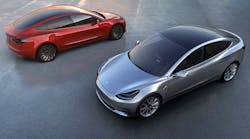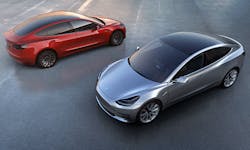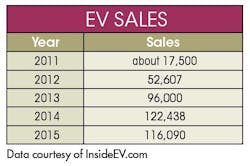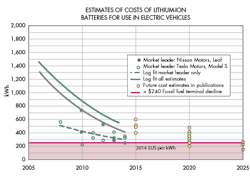Charged Up: Where Do Electric Vehicles Go from Here?
This file type includes high resolution graphics and schematics when applicable.
While debate continues over whether electric vehicles (EVs) are actually environmentally superior and more cost-efficient than those powered by fossil fuels, the fact is that fully electric cars and hybrids are gaining in popularity and sales.
Sales of EVs, such as the Nissan Leaf and Chevy Volt, have grown steadily since 2011. While last year saw a slight drop in this segment overall, Tesla Motors CEO Elon Musk says his company currently has almost 400,000 pre-orders for the Model 3. To maintain EV growth, the industry will have to consider economical cost, environmental cost, and infrastructure.
The U.S. government has been aiding efforts to increase the popularity of EVs and grow their infrastructure. In December 2015, the federal government extended incentives for EV charging stations through 2016. More state governments are signing a Memorandum of Understanding for a State Zero-Emission Vehicle Program by which signatory states, in short, will support the expansion of EVs. Some states are even offering incentives for people and businesses that purchase EVs and EV charging equipment.
Charging is also possible with a basic 120-volt plug. However, that approach can take a long time. Eight hours of charging on a 120-volt plug might offer about 40 miles of driving. In contrast, installing a 240-V line allows a range of 20 to 40 miles after two hours of charging. Some companies have designed rapid chargers that supposedly provide a full charge in as little as 15 minutes.
Rapid charging and high-load requirements can decrease the life expectancy of the battery by adding stress. Like many things, reducing stress over time can prolong a component’s life. Keeping Li-ion batteries “topped off” is the best option, but not always realistic. Researchers are helping to prolong EV range while keeping batteries charged. At Oak Ridge National Laboratory, researchers testing wireless options were able to transmit 20 kW to a passenger vehicle at about 90 to 95% efficiency. By comparison, the Advanced Power Electronics Lab (APEL) at Kettering University collaborated with HELLA, an automotive electronics company, to develop a compact vehicle charger with an efficiency of 97%, more than 3% over the average for these plug-in chargers.
SAE J2954 focuses on wireless suppliers and infrastructure involved in wireless charging. It will be important to manufactures and utilities to have standards for cohesive charging and safety. While wireless charging isn’t inherently dangerous, a system to prevent foreign-object debris from entering the area between the primary and secondary charging units while active will reduce problems, damage, or inefficiencies.
“You have two types of wireless charging,” says Joachim Taiber, CTO of the International Transportation Innovation Center (ITIC). “The first type is when a vehicle is stationary. This could mean parked or, for example in a city, stopped at a red light. Looking forward, a second type allows an EV to charge while moving. A car could drive over a sequence of coils in the road to charge. You could charge multiple vehicles in parallel without needing them to stop.”
Both types of wireless charging can extend range and extend battery life for EVs. The infrastructure to integrate either type will be expensive, but could also present new ways for generating income. More complex infrastructure, such as wireless charging in the road could aid in automated driving capabilities. However, charging can be more complicated as some EVs use alternating current (ac) and others are direct current (dc). This means it’s critical for EV and charging-station manufacturers to communicate and set up standards so that all EVs have the right equipment to charge.
Compared to dc, ac motors offer higher torque and speeds. They also are more adaptable to variable speed and loads, so they work better for hills. They also accept energy from regenerative braking easier than a dc motor. But the coil winding can be heavy, and an inverter is necessary when using batteries to convert the dc battery to ac motor. In general, an ac motor costs more than a comparable dc motor.
Overall, there are automotive and off-road applications for ac and dc motors. But to make electric motors and EVs viable it, will take major advances in battery technology. The current energy storage necessary to power EVs adds too much weight, making the weight-to-power ratio too high. Wireless charging could be part of the answer. There are also the problems of slow recharging and environmentally clean disposal.
Infrastructure
According to the Natural Resources Defense Council, “While electric vehicles are cleaner than petroleum-fueled vehicles today, the greenhouse gas reductions can be maximized by charging vehicles from a cleaner grid. With a 62% share of light- and medium-duty vehicles in 2050, electric vehicles would consume 13% of grid-supplied electricity.” A 120-V overnight charge will pull about as much power as a 1500-W window air conditioner. Level 2 charging—the 240-V plug—is the same as an electric dryer or oven. This demand for power is not abnormal. Also, considering users would probably charge during off-peak hours to save money, some reports say any increase in electricity demand from EVs will not be an issue. However, some grids will run coal plants in the evening that will reduce the environmental benefits of the EV.
In fact, EVs might not only pull electricity from the grid, but could act as a resource. The German utility STEAG is investing about $112 million in Li-ion battery storage to help with short-term fluctuations in energy demands on the grid. LG Chem will supply 140-MegaWatt-hours (MWh) to the energy storage system in Germany. Mass adoption of EVs means that the batteries can help stabilize fluctuations in electric demand. Battery size changes with each model, but electric storage like this represents about 2,000 to 7,600 smart cars plugged into the grid. This would require a smart system to make sure the EV user is able to have enough of a charge at the end of the day. Southern California Electric (SCE) is working with the U.S. Department of Defense on a one-year pilot at the LA Air Force Base looking at the feasibility of this concept. In addition, SCE believes a significant increase in EV charging may help integrate renewable energy, such as solar, into the grid.
Incentives
Both federal and state governments are offering rebates to help offset the cost of EVs and charging equipment. According to IRC30D from the IRS, up to $7,500 in credit can be received per vehicle. “For vehicles acquired after December 31, 2009, the credit is equal to $2,500 plus, for a vehicle which draws propulsion energy from a battery with at least 5 kilowatt hours of capacity, $417, plus an additional $417 for each kilowatt hour of battery capacity in excess of 5 kilowatt hours.” In its current wording, however, this incentive does have limits: “The credit begins to phase out for a manufacturer’s vehicles when at least 200,000 qualifying vehicles have been sold for use in the United States (determined on a cumulative basis for sales after December 31, 2009).”
Incentives can help offset the difference in the cost of EVs and fossil-fueled vehicles, but how large is the price gap? The U.S. Department of Energy provides a calculator that lets users compare cost and emissions of specific cars side by side. A comparison of the 2016 Nissan Leaf and Versa showed a difference in $0.04/mile for about 12,000 miles a year for New York state. Despite this, the Versa is still more cost effective, largely due to the lower purchase price. After five years, the cost difference can be about $15,000 according to the calculator. Incentives can help reduce this difference in cost. If a user is considering a full-size vehicle, for example the Nissan Altima, EVs become more cost-competitive—keeping in mind that cost difference varies on fuel and electric cost.
Some consumers have the preconceived notion that EVs are inherently better for the environment, but research conducted by the Union of Concerned Scientists in 2012 shows that EVs generate about one metric ton more in greenhouse gases during manufacturing than a similar gasoline vehicle. Consumers instead should be alerted that, as stated in the report, using an EV will rectify this difference in emissions in the first year of driving. If the batteries are recycled properly, a cradle-to-grave analysis shows EVs do have about a 50% emission savings, according to the Union of Concerned Scientists.
This can change, depending on from where the electricity comes. For example, according to the U.S. Energy Information Administration, the highest weight of CO2 per kW-h produced is lignite—a brownish coal with traces of plant structure. Lignite can produce up to 2.17 lb of CO2 per kW-h, which could greatly increase emissions if an EV was using this to charge. However, coal produces 33.28% of U.S. electricity, and the environmental benefit of EV charging increases with different energy sources. Natural gas produces 1.22 lbs. of CO2 per kW-h, and alternative energy sources produce even less.
A recent report in Scientific American notes, “As it stands, a conventional Toyota Prius hybrid vehicle, which burns gasoline when its batteries are not engaged, and the all-electric Nissan Leaf produce roughly the same amount of greenhouse gas pollution: 200 grams per mile, according to data from the U.S. Department of Energy.” In comparison, the EPA reports that an average passenger vehicle with 24.1 mpg would produce 368.4 g/mile, and 513.5 g/mile for light-duty trucks with 17.3 mpg.
The Scientific American report continues, “In California, which has one of the highest proportions of clean electricity in the country, the electric vehicle would produce only 100 grams per mile, half that of the hybrid. Ditto for Texas and even Florida. But in the Midwest and South, where coal fuels the bulk of electricity generation, a hybrid produces less CO2 than an electric car. In fossil-fuel–dependent Minnesota, an electric car would actually emit 300 grams per mile of greenhouse gases. As a result, some researchers suggest that a regional approach to clean vehicle standards makes more sense than national standards that effectively require electric cars across the board. Minnesota could go for hybrids and California could go for electric vehicles.”
With government support, a growing infrastructure, and exponential growth in public interest, it looks like the EV market will continue to expand despite argument. However, some aggressive projections as far out as 2050 still do not have EVs overtaking the traditional internal-combustion-engine vehicle.
The Bumpy Recent History of EVs
In 2010, investing in an EV may have been questionable. There were far fewer charging stations, concerns about the vehicle’s range, and uncertainty over whether it was saving the buyer any money. In addition, memories of General Motors’ EV-1 (also known as the Saturn EV-1) from the mid-’90s might have scared away potential buyers. The first major automobile brand to produce a modern, full-plug-in EV was wrought with controversy that ultimately left those who leased the car forced to return them to the manufacturer. With all of the cars officially leased and no option to purchase and own one, General Motors was able to take back the cars and ended up destroying them. There is only one working model left; it is on display at the Smithsonian. (The controversy of the EV-1 sparked enough outrage that in 2006, Jessie Deeter produced a documentary called, "Who Killed the Electric Car?").
Beyond that PR nightmare, the plethora of inaccurate and conflicting information certainly didn’t help the electric vehicle’s cause. In 2007, CNW Marketing Research published “Dust to Dust: The Energy Cost of New Vehicles from Concept to Disposal,” a report stating that an H1 Hummer produced less pollution —cradle to grave than a Prius. It only took about two months until the Pacific Institute published “‘Dust to Dust’ Report Misleads the Media and Public with Bad Science.” Others have come forward to confirm the poor research presented in the CNW report, but proponents are still quoting and sharing its information. Other studies question the economic and environmental benefit of EVs, but they typically depend on what region the EV is located in and what vehicles the study is comparing.
Today, EV adoption is finally gaining traction. Aftershocks from the EV-1 recall are mostly resolved. Charging stations have steadily been increasing over the years. It’s also become more common for EV owners to have permits so they can have charging stations at home. In addition, EV boosters are pushing government officials to streamline the process whereby they can have a charging station installed in their homes.
Looking for parts? Go to SourceESB.
This file type includes high resolution graphics and schematics when applicable.







